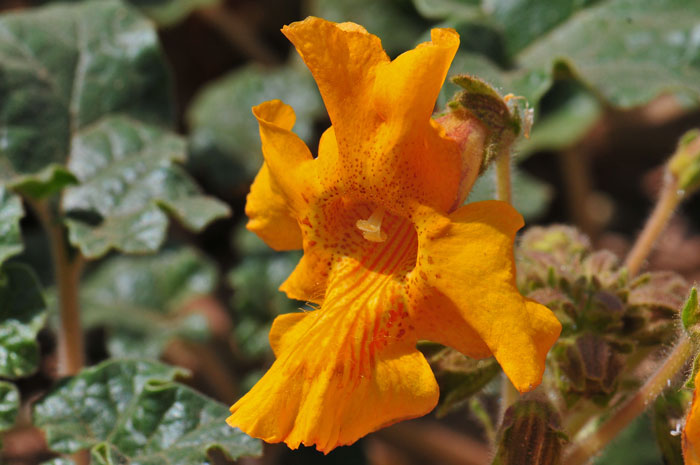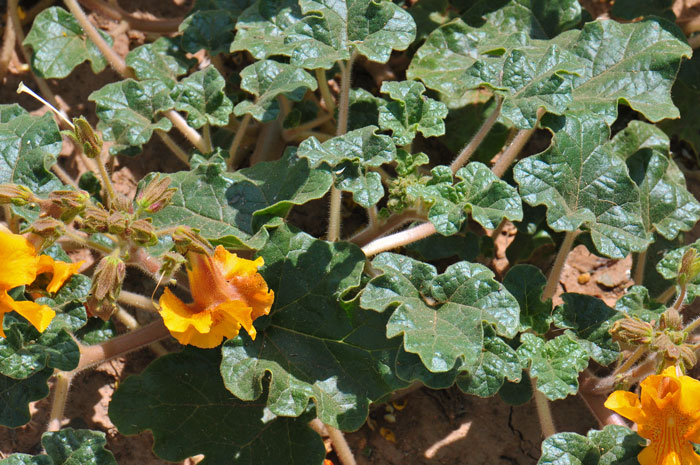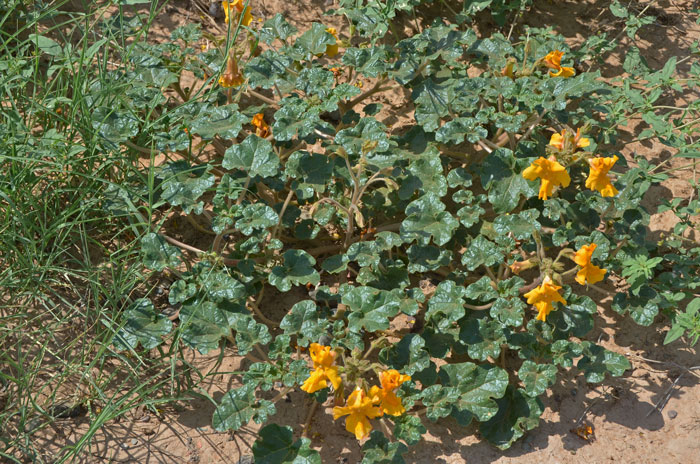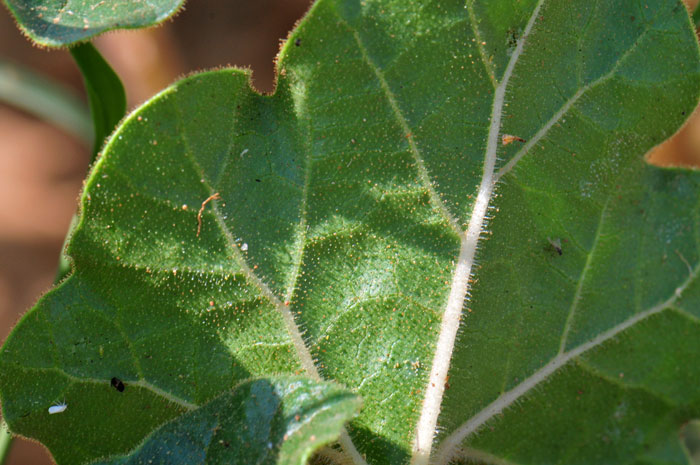Proboscidea althaeifolia, Desert Unicorn-plant





Scientific Name: Proboscidea althaeifolia
Common Name: Desert Unicorn-plant
Also Called: Desert Unicorn-plant, Devil's Claw, Devilsclaw, Devilshorn, Straighttube Unicorn Plant (Spanish: Campanita, Cuernitos, Espuela del Diablo, Uña del Diablo, Cuernos del Diablo)
Family:
Pedaliaceae or Pedalium Family
Synonyms: (Martynia althaeifolia, Martynia arenaria, Proboscidea altheifolia, Proboscidea arenaria)
Status: Native
Duration: Perennial
Size: Low growing trailing vine up to 2 feet more or less wide.
Growth Form: Forb/herb; plants course (see photo above) root tuber-like, yellow, stems decumbent.
Leaves: Green; large and lush, up to 2.5 inches wide, mostly palmately (3) lobed), broadly ovate, round or triangular, sinuately-lobed (see photo above), margins crenulate.
Flower Color: Yellow to orangish, bell-shaped flowers, lower flower lobe maroon-brown-streaked and spotted in 2 rows along upper side of throat; nectar guides orange-yellow; flowers large, fragrant, showy, up 5 or more flowers per plant (50); inflorescence a raceme; calyx with lobes much shorter than the tube; fruit a large, up to 8 inches seed-pod in the shape of a fleshy claw that splits into 2 dry claw-like halves at maturity.
Flowering Season: July to September.
Elevation: Up to 2,500 feet.
Habitat Preferences: Uncommon, desert conditions in damp, moist, sandy soils and arid grasslands.
Recorded Range: Desert Unicorn-plant is restricted to the southwestern United States in; AZ, CA, NM and TX. It is also native to Baja California, northern Mexico and Peru South America. In Arizona it occurs in the southern half of the state and in the northwest (Mojave County).
North America & US County Distribution Map for Proboscidea althaeifolia.
U.S. Weed Information: No information available.
Invasive/Noxious Weed Information: No information available.
Wetland Indicator: No information available.
Threatened/Endangered Information: No information available.
Genus Information: The USDA Plants.gov website shows that North America has 5 species in Proboscidea.
The USDA Plants.gov also reports that Arizona has 2 species in Proboscidea, California has 3 species, New Mexico has 4 species and Texas has 5 species.
The Plant List includes 33 species rank for the genus Proboscidea. Of these 10 are accepted species names.
Comments: The distribution of Desert Unicorn-plant in Mohave, County, Arizona marks the northern most location of this species in the United States. Desert Unicorn-plant has unique fruits that split into hard dry devils claws that have been used as tools by local Native Americans (see ethno-botanical uses below). There are several species in Proboscidea in the Southwest, some with pink or magenta flowers.
In Southwest Desert Flora also see Doubleclaw, Proboscidea parviflora.
Desert Unicorn-plant is used by the Pima as an analgesic (plant moxa used for rheumatic pains) and by the Cahuilla as a tool (hooked thorns used as a tool in mending baskets and broken pottery. See ethno-botanical uses at Native American Ethnobotany, University of Michigan, Dearborn.

